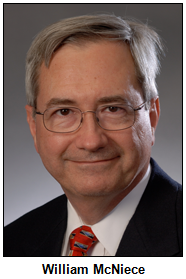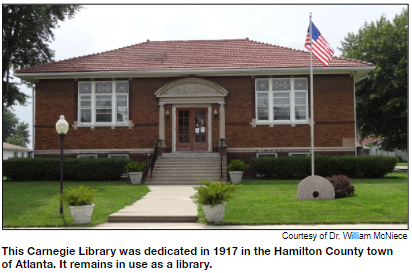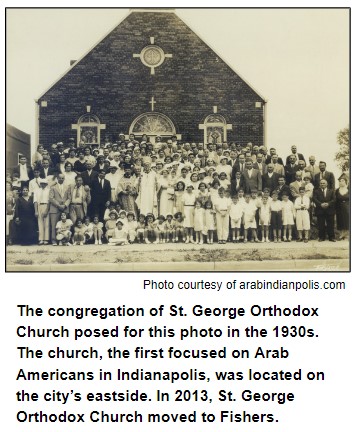Hoosier History Live is an independently produced new media project about Indiana history, integrating podcasts, website www.HoosierHistoryLive.org, weekly enewsletter, and social media. Its original content comes initially from a live with call in weekly talk radio show hosted by author and historian Nelson Price. You can hear the show live Saturdays from noon to 1 pm ET at WICR 88.7 fm or stream the show live at the WICR HD1 app on your phone, or at our website.
March 02, 2024
Carnegie Libraries in Indiana

How often does Indiana rank as the No. 1 state in a national list? Well, here's a record for the books: More Carnegie Libraries were built in Indiana than any other state.
Between 1901 and about 1918, 164 public libraries built in large part by funding from philanthropist and industrialist Andrew Carnegie (1835-1919) were constructed in Indiana. More than 100 of them are still used as public libraries across the state. Others have been repurposed as everything from restaurants to museums, art galleries, local government offices and civic centers, with many retaining the "Carnegie" name in some way.
 To explore a range of aspects about "the Carnegies" – which include two branches still in use in the Indianapolis Public Library system – Nelson will be joined by studio guest Dr. William McNiece, president of the Marion County Historical Society, who has done a deep dive into the topic. The first Carnegie Library built in Indiana was in Goshen and the last town to receive funding was Lowell, Ind. OF Indiana's 92 counties, only 9 did not receive any Carnegie funding for a public library, according to Dr. McNiece.
To explore a range of aspects about "the Carnegies" – which include two branches still in use in the Indianapolis Public Library system – Nelson will be joined by studio guest Dr. William McNiece, president of the Marion County Historical Society, who has done a deep dive into the topic. The first Carnegie Library built in Indiana was in Goshen and the last town to receive funding was Lowell, Ind. OF Indiana's 92 counties, only 9 did not receive any Carnegie funding for a public library, according to Dr. McNiece.
During our show, we will explore the commitments that cities and towns needed to make (including a pledge to have funds available annually for maintenance) to receive Carnegie funding for libraries as well as Carnegie's preferences on the designs for them. We also will discuss various explanations about why Indiana had more public libraries funded by Carnegie than any other state.
In Carmel and Greenfield, Carnegie Libraries have been repurposed as popular dining spots, Woody's Library Restaurant and Carnegie's Restaurant. In New Albany, the former library is now the Carnegie Center for Art & History. The Anderson Museum of Art is Anderson's former Carnegie Library, which was built in the beaux arts style and has a stained glass domed ceiling.
In the Indianapolis Public Library system, the East Washington Library and the Spades Park Library were built as Carnegie Libraries. The city received funding for six libraries. Two of the others have been razed, and another has been repurposed as the Hawthorne Center for Working Families. The sixth that received funding never was built; during our show, Dr. McNiece will explain why.
 The 106 Carnegie-funded libraries still being used as public libraries include those in the towns of Wabash, Boswell and Atlanta. "Some, if not most, have been architecturally modified to make room for bigger collections and modern technology," according to a blog by Regan Steimel, a reference librarian at the Indiana Historical Society. As a resource, Regan and our guest Dr. McNiece recommend the book "Temples of Knowledge: Andrew Carnegie's Gift to Indiana" by Alan McPherson.
The 106 Carnegie-funded libraries still being used as public libraries include those in the towns of Wabash, Boswell and Atlanta. "Some, if not most, have been architecturally modified to make room for bigger collections and modern technology," according to a blog by Regan Steimel, a reference librarian at the Indiana Historical Society. As a resource, Regan and our guest Dr. McNiece recommend the book "Temples of Knowledge: Andrew Carnegie's Gift to Indiana" by Alan McPherson.
Dr. McNiece, an anesthesiologist at IU Health's Riley Hospital for Children, has been a previous guest on Hoosier History Live shows, including programs about Epidemics in Indiana history in 2014 and the Influenza Epidemic of 1918-19. He has made presentations about Carnegie Libraries to various civic groups in Indiana.
New show podcasts are up!

For a complete list of show podcasts and show enewsletters, please go to ARCHIVES on our website.

Your contributions help keep Hoosier History Live on the air, on the web, in your inbox, and in our ARCHIVES!


 Major landmarks in downtown Indianapolis today include
Major landmarks in downtown Indianapolis today include  Nelson and Edward will be joined for part of the show by Diana Najjar, a retired Indianapolis teacher of Lebanese heritage. Her grandparents were among the founders in the mid-1920s of
Nelson and Edward will be joined for part of the show by Diana Najjar, a retired Indianapolis teacher of Lebanese heritage. Her grandparents were among the founders in the mid-1920s of 
